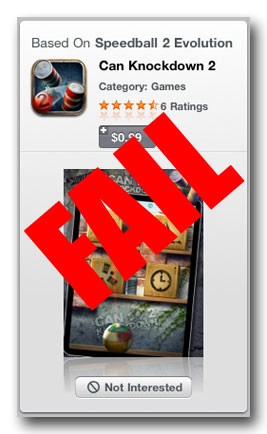As was widely speculated, Apple’s press conference in San Francisco last month (YouTube, 1:11:52) did indeed reveal a thinner, lighter Steve Jobs. Fortunately, the company’s CEO seems to have made a full recovery from serious illness because his insanely great capacity for spewing corporate marketing horseshit was not diminished in any way. The reality distortion field was in full effect as evinced by the fact journalists reported every single marketing point gushingly.

Someone immune to the RDF would have come away unimpressed from the unveiling of the iPad 2 and its Smart Cover, however. The highlighting of “polyurethane” (Latin for “taking the piss out of many people”) and the magical properties of magnets perhaps bespeak quiet desperation on the part of Apple marketing.
Though the iPad 2 is undoubtedly an improvement, it may not necessarily be that irresistible an upgrade for everyone. The iPad 2’s faster processor wouldn’t let users read e-books or watch movies any faster nor would they be listening to music any quicker. Web pages may render faster but the primary bottleneck when surfing will be bandwidth rather than processing power. Thinner and lighter are, of course, things to celebrate when it comes to hardware but the iPad 2 is just not thin or light enough to warrant effusive praise. The iPad 2 is still a portable device rather than one that fits in a pocket and every ounce of its 1.3 pounds will be felt after holding it for an hour.
The original iPad, now that it’s been discounted to a shade under USD400, continues to be an attractive option. It’s easy to understand why Jobs has sold 15 million of his sugar tablets in nine months. The iPad looks great out of the box, feels solid in hand and holds up well in use. The 10-inch IPS display is a delight, the battery life is staggering (10 hours of use with a 4-hour recharge!) and the interface is mostly intuitive and slick.
As can be expected of a product from a company obsessed with presentation and marketing, everything is embellished and chromed, and superfluous animations abound. For no reason whatsoever, editing the home screen layout causes app icons to nervously tremble as if filled with trepidation they are about to be deleted by a callous user unappreciative of just how much creativity, thought and effort went into producing those shiny, curvy designs.
The most astonishing thing about the iPad, however, is that it’s currently significantly cheaper than its competition. We are now living in a world where Apple’s hardware offers the best bang-for-the-buck and has the widest selection of software.
Is this, as Jobs would have us all believe, a “post-PC” world?
Developers, developers, developers, developers
Jobs understandably took pains during the press conference to highlight one of the key strengths of the iOS platform, the App Store. He noted there were 350,000 apps available on it and app developers were paid over USD2 billion. Those are hugely impressive numbers when considered separately. As gaming industry veteran Trip Hawkins astutely pointed out, however, the numbers become significantly less impressive when put together. Though his data was outdated, the point remains sobering for developers: the average iOS app earns less than six thousand dollars.
Most app developers will struggle to attract attention let alone emulate the breakout success of Angry Birds and even major publishers like Electronic Arts are resorting to aggressive price cuts to stand out in the crowded iOS marketplace. The current marketing strategy for iOS developers and publishers seems to be to aim for the 99 cent impulse buy price in order to gain the massive exposure from the Top Charts list. It’s a sound strategy since it appears the userbase would buy anything for a dollar.

iDabble
For the consumer, the App Store stands out for its cheap, bite-sized apps. These exist on desktop computers as well but not in the same voluminous numbers as in the App Store and more importantly, these generally aren’t produced for the desktop by major developers.
Perhaps the quintessential example is GarageBand for the iPad, Apple’s entertaining music creation and editing app. Costing less than five dollars, this app is capable of creating an 8-track song using canned loops, recorded audio or the app’s built-in musical instruments. This could be and has been used by professional musicians but most GarageBand users will treat it like a music toy, one particularly well-suited to making loud guitar-y noises after yelling out, “We are Wyld Stallyns!” That’s no surprise given Apple’s Director for Music Marketing stressed GarageBand was designed to be fun even for those who’ve never played a note before.
And that really is the iPad app experience in a nutshell: cheap and aimed at undemanding users unconcerned by a limited feature set.
Similarly, the iOS gaming scene is mainly for those looking for quick, cheap thrills — bubble gum gaming in other words. These are games users can easily pick up and dive right into but ultimately, these are games that are completely forgettable and disposable.
There’s nothing about the hardware that prevents designs with richness, depth and complexity but the pressure of the 99 cent marketplace coupled with a userbase with a limited gaming vocabulary and attention spans far too short for extended tutorials and lengthy manuals will mean ambitious game developers aren’t likely to find much joy here.
Unambitious game developers looking to make a quick buck, on the other hand, will find the iOS platform to be a delightful playground because the userbase has no problems with awkwardly retrofitted virtual controls, unethically recycled designs and cynically exploitative microtransactions.
iDistinguish
The main problem with the App Store for the discerning consumer is it’s nigh impossible to separate the wheat from the chaff. The App Store does have Genius for Apps recommendations, a feature requiring users to submit information about their app purchases to Apple as a basis for making suggestions for related apps, but these suggestions are usually insultingly bad.

Apple’s decision-making in approving apps for its App Store is hardly suggestive of genius either. What message is the company trying to convey when it rejects harmless yaoi romance comics but accepts an app touting a cure for homosexuality? The latter was pulled but only after 150,000 petitioners protested. Commenting on the decision to pull the app, an Apple spokeswoman said the app violated “developer guidelines by being offensive to large groups of people”. The implication is that if “large groups of people” were homophobic, misogynistic, xenophobic or bigoted then Apple would be perfectly fine with apps espousing their views.
There are user reviews but these are nearly useless for those who value actual critical appraisal instead of mere ratings, hyperbole and cursory dismissal.
i-Yi-Yi
The only thing worth paying attention to in user reviews is reports of crashing because whatever Apple is doing to vet apps for the App Store, the process certainly doesn’t include quality control. Despite being on standard hardware configurations and a standard OS platform, apps crash and some do so with annoying frequency.
When apps do crash, users are simply returned to the home screen without any explanation, which suggests Apple has trouble envisioning scenarios where not everything “Just Works,” Nevertheless, these scenarios aren’t uncommon. This could be blamed on the developers rather than the OS but it doesn’t helps matters the OS itself shrugs off problems nonchalantly without providing any indication of what caused them.

The problem appears to be mainly memory-related. The original iPad includes 256MB of RAM, which is adequate most of the time given that iOS is much more compact than desktop OSes. However, if 640KB of RAM really wasn’t enough for everyone on the PC, neither it would seem is 256MB of RAM on the iPad. Memory-hogging apps like Dungeon Defenders: First Run and ArtRage will run out of memory and crash. The current suggested workaround for this is to completely shut down the iPad — hold the power button for a few seconds then swipe the red slider when prompted — to clear out memory before restarting the device and launching the app again. The iPad 2, with double the original’s RAM (a quiet admission on Apple’s part the original iPad was lacking in this area), should be less susceptible to this but there’s no reason to expect upcoming apps which tax the iPad 2’s capabilities won’t run into the same problem.
iConsume
The iPad is being pushed as a media consumption device and it performs that task well. For the casual user, it’s definitely a nice way to experience the web and its panoply of wonders. The iPad’s default browser, Safari, starts up quickly, web sites look great on the large screen, and text is eminently readable.

Third-party apps like Flipboard are a revelation in the way they re-envision the web. Even an anachronistic social network like Twitter — a service so backward, goatse.cx-ing is once again viable — is transformed into something novel and exciting. That said, there’s nothing about Flipboard that screams, “This is only possible on the iPad.”
Anyone looking to refine the web experience on the iPad will be left disappointed because Safari lacks the extensibility and customisation options of even its desktop counterpart. There are third-party web browsers which provide some of the functionality missing from the default browser but for someone used to the mighty Proxomitron‘s filter set and Opera’s speedy mouse gestures on the desktop, surfing the web with the iPad will still be an underwhelming experience.
While this could be shrugged off by some, the web is increasingly an unpleasant place to be and users need robust tools to weed out annoyances and maintain peace of mind. Here the iPad falls short and this should be an area of concern for both Apple and iPad owners. The iOS platform is not without its share of security vulnerabilities as the documentation for recent updates reveals repeated use of the phrases “maliciously crafted” and “arbitrary code execution,” and Apple can no longer rely on security through obscurity when there are over 100 million iPhones and 15 million iPads out there in the wild.
iDoubt
The iPad, like all portable devices, is characterised by the compromises made for the sake of portability. For every one of its plusses, the iPad has a minus that cannot be simply shrugged off. The large display is terrific but it will be tiring to hold the device for prolonged periods of time. Reading text is a joy but editing text is frustrating. Multi-touch gestures are novel and tactile but lack the precision and speed of the mouse and keyboard.
The problem is exacerbated in the iPad’s case because the user experience is further compromised by Apple obligating its users to do things the Apple way. This is exemplified by iTunes. There’s little need to run through why it’s annoying since Charlie Brooker has performed a surgical strike in his inimitable style. (The phrase “tight, leathery anus” is unlikely to appear in any other software appraisal.) There’s no reason for the iPad to be this tightly tethered to iTunes bar Apple’s pathological need to control every aspect of its hardware and software.
This zealous desire for control impacts the user in all sorts of ways, major and minor. For instance, the iPad is much less appealing for owners in some countries since Apple doesn’t sell music and books through the iTunes and iBooks stores worldwide and without those stores, iTunes and iBooks exist merely to add unnecessary glitz and bloat to music, e-book and PDF management. Simply getting files unsupported by iTunes to and from the iPad is a clumsy process requiring third-party apps.
There are murmurings Apple may fully embrace the cloud eventually but it’s difficult to imagine the company would be willing to do something so radical like letting users freely use their iPads the way they want to.
This is the crux of the matter with the iPad. Everything “Just Works,” true enough, but crucially, however, nothing “Just Works The Way You Personally Want It To.” Getting into the Apple iOS space means ceding control to Apple, trusting that Apple knows all and Apple knows best. Only Steve Jobs, corporate bullshitter extraordinaire, could spin this restriction and limitation as “freedom” and indeed, he has.
These restrictions and limitations may be great for those who have no idea what they’re doing nor care about how they’re doing it — some people absolutely love having others make decisions for them, their bovine docility unperturbed as they are led by the nose by a Fortune 500 company — but deeply frustrating for those who do.
So that’s the iPad: impressive hardware and fantastic third-party support; it’s just a shame it’s an Apple product.
RIP, PC?
Steve Jobs may use the phrase “post-PC” repeatedly until journalists unthinkingly repeat it themselves but that doesn’t make the phrase any truer. Anyone who uses the phrase should be forced to justify it with a 2,000-word article written entirely with the iPad’s virtual keyboard. Whining pleas for a bluetooth keyboard should be icily dismissed since an iPad with a bluetooth keyboard is little more than a half-assed netbook. The iPad’s reliance on the PC is apparent from the moment the tablet device is first turned on when it whimpers about needing a computer with iTunes installed on it.
The PC platform has survived Palm PDAs, RIM BlackBerry devices, Apple Newton MessagePads, smartphones and it will survive tablets as well. Just as there will be times when portability is needed, there will be other times when the PC’s power, flexibility and versatility are of paramount importance.
As a device category, tablets best function as complementary devices rather than replacements. They’re fantastic for bedtime reading, passing the time in a waiting room or providing a quick distraction for Generation Internet. The iPad fulfills this role well enough but it is neither unique in that role nor is it without faults and limitations, and anyone keen on getting one must keep this in mind.
